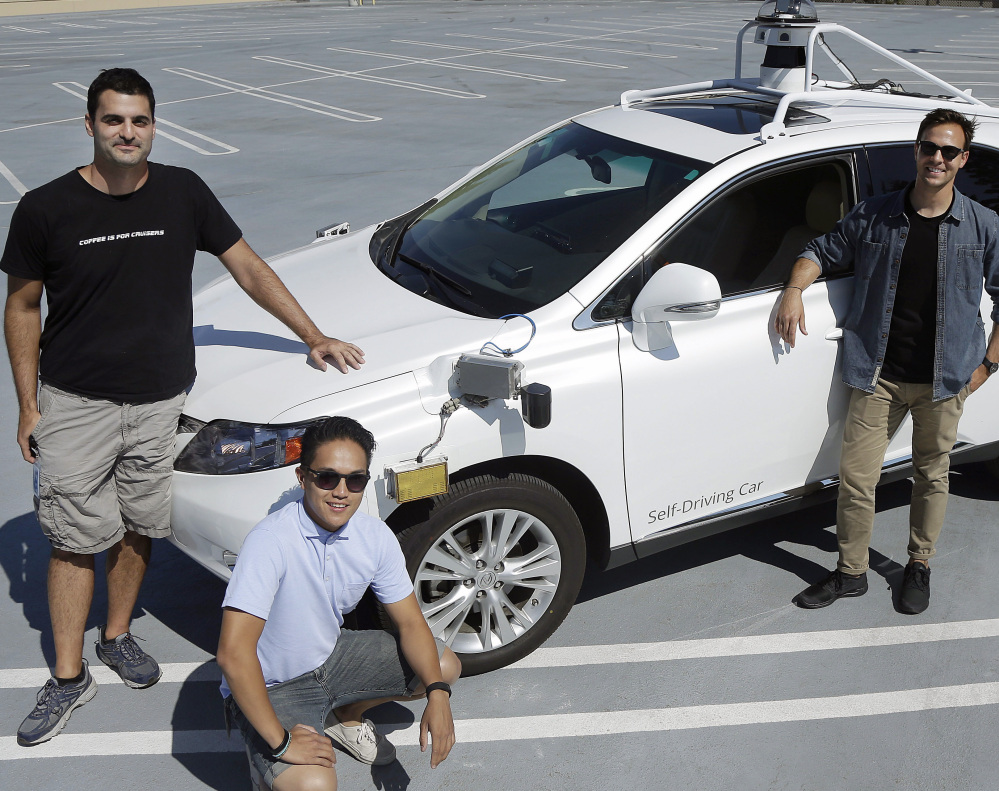MOUNTAIN VIEW, Calif. — After a friend recommended that he join a secret Google project six years ago, Brian Torcellini suddenly found himself on the road to an occupational oxymoron. He became a driver in a driverless car.
Torcellini, 31, leads a crew of test, or “safety,” drivers who are legally required to ride in Google’s fleet of 48 robot cars.
They only take control in emergencies. Otherwise, they make observations that help the Internet company’s engineers program the cars to navigate the roads without human assistance.
“A lot of people go to work and sit in a cubicle,” Torcellini says. “Our cube just happens to move around the roads. And if we are successful, we are going to put ourselves out of a job.”
The driverless cars already have logged more than 2 million miles in six years of sometimes tedious testing on private tracks, highways and city streets located mostly near Google’s Mountain View, California, headquarters.
The vehicles have traveled more than half that distance in automated mode, with one test driver in place to take control of the car if the technology fails or a potentially dangerous situation arises. Meanwhile, another driver sits in the front passenger seat typing notes about problems that need to be fixed and traffic scenarios that need to be studied.
“I don’t want to compare myself to an astronaut, but it kind of feels like that sometimes,” says Google test driver Ryan Espinosa while riding in an automated Lexus that recently took an Associated Press reporter on a 20-minute ride around town without requiring any human intervention.
If the technology advances as Google envisions, the only people sitting in driverless cars by 2020 will be passengers looking for an easier way to get around.
Even fewer test drivers will be working because the driverless cars will be completely autonomous, eliminating the need for the vehicles to be equipped with steering wheels or brake pedals. Everything will be controlled through a combination of sensors, lasers, software and intricate maps.
The job requires a sense of adventure, something Torcellini acquired when he began to surf in high school. His other passions include spear fishing and scuba diving, which he likens to the sensation he gets when he climbs into one of Google’s self-driving cars and pushes the button that activates the vehicle’s robotic controls.
“When you go scuba diving and take a moment to really think about it, you realize you are doing something that isn’t supposed to be humanly possible: you are breathing underwater,” Torcellini says. “It’s the same kind of feeling you get in one of these cars. It’s not supposed to be humanly possible.”
While the engineers who are programming the robot cars have technical backgrounds, most of the test drivers don’t.
Torcellini worked in a drug store warehouse while getting his degree in political science at San Diego State University. He dreamed of pursuing a career writing about surfing. He ended up at Google in 2009 after a friend who worked for the company suggested he interview for an opening on a then-secret project.
Espinosa, 27, was working in a bicycle shop before he was hired as a test driver two-and-half years ago.
Besides having clean driving records, Google’s test drivers say the job requires a combination of good judgment, patience and fearlessness.
The self-driving cars were in 16 accidents from May 2010 through August, but they are becoming more frequent as the vehicles spend more time on public roads.
Half of the collisions have happened since February – a stretch when the self-driving cars were traveling an average of about 10,000 miles per week on public streets in autonomous mode. There have been no major injuries reported so far.
In all but three of the accidents, Google’s self-driving cars have been rear-ended, a trend that the company believes has to do with the large number of motorists who are texting, talking on the phone or otherwise doing something besides paying strict attention to the roads and their surroundings.
Send questions/comments to the editors.



Success. Please wait for the page to reload. If the page does not reload within 5 seconds, please refresh the page.
Enter your email and password to access comments.
Hi, to comment on stories you must . This profile is in addition to your subscription and website login.
Already have a commenting profile? .
Invalid username/password.
Please check your email to confirm and complete your registration.
Only subscribers are eligible to post comments. Please subscribe or login first for digital access. Here’s why.
Use the form below to reset your password. When you've submitted your account email, we will send an email with a reset code.